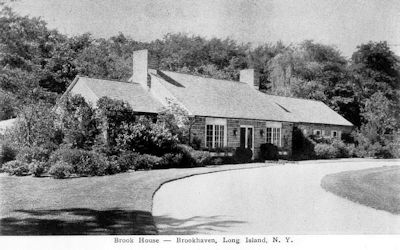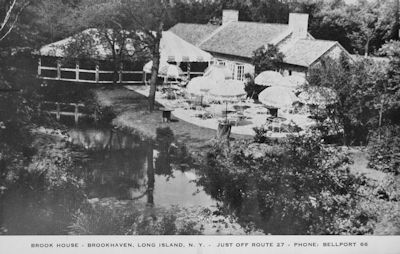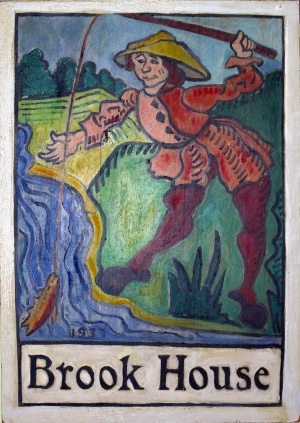The Brook House
This article originally appeared in The Barn News, The Newsletter of the Bellport-Brookhaven Historical Society, Bellport, New York 11713. Volume 11 Number 2 (June 2009). Used by permission.
The article was compiled by Ginny Waterman from interviews with Nancy Wellington Lee and others.
The Brook House
There is a one-story stone building at 405 South Country Road, Brookhaven on the right side of the road if you are going toward Bellport, or the left if you are heading into Brookhaven Hamlet built on a very historic site. ![]()
Today it is the home of L. K. McLean Associates, but the real point of interest is, not what the property was historically or what the building is today, but when it was the Brook House during the late ‘30s to the early ‘50s, “a tearoom and restaurant of great charm and serving delicious food.” ![]()
Nancy Lee Remembers the Brook House
Curious to know more about the restaurant, I sat with Mrs. Nancy Lee, daughter of C. Oliver Wellington, to talk about the Brook House.
For the beginning of the story, Ms. Lee stated that she “was remembering through the eyes of a 6-year old.” But believe me, this “6-year old” remembered a lot!
“In the nineteen thirties, my father, C. Oliver Wellington, ![]() came down with a fever. He was quite ill. All he could think of during this time was if only he could have some fresh home-made ice cream. He already had a small herd of Jersey cows on his property in Brookhaven. Why not make his own ice cream!! And so began the Brook House, a place for ice cream and high tea. Of course, this did not happen as quickly as he would have liked. One had to find the land to build on,
came down with a fever. He was quite ill. All he could think of during this time was if only he could have some fresh home-made ice cream. He already had a small herd of Jersey cows on his property in Brookhaven. Why not make his own ice cream!! And so began the Brook House, a place for ice cream and high tea. Of course, this did not happen as quickly as he would have liked. One had to find the land to build on, ![]() the architect to design the building,
the architect to design the building,![]() hire a manager and the help, etc. Some of the original waitresses were local girls such as Connie Bohn Borntraeger and Betty Brown Bossler.
hire a manager and the help, etc. Some of the original waitresses were local girls such as Connie Bohn Borntraeger and Betty Brown Bossler.
“The tea house-ice cream parlor was a big success, but a year later it was decided to turn this place into a real dining experience with very good food and New York restaurateurs to man it.
“Of course it could only be in operation during the summer because there was no heat in the building. The restaurant had been conceived as a summer attraction with all pipes from it going under the brook and up the hill behind it. Therefore, all discharge would freeze.
“A screened-in porch was built over the brook, greatly adding to the room for tables and chairs. Attractive decor added to the ambiance of a wood-burning fireplace, the main focus to the right as you walked into the main dining room. There were two antique wood settles facing each other in font of the fireplace; tavern chairs with caned seats [I still have some of the original chairs (shown left?)], colorful blue chintz drapes, and green chair cushions. I remember white walls and gray French mural panels over the fireplaces at each end of the long room.

New Tea-house Opens at Brookhaven Soon
“Brook House,” the new and beautiful tea-house designed by Aymar Embury and build by Mr. And Mrs. C. Oliver Wellington… will be open to the public Saturday, June 19.
The Advance, June 4, 1937
“Fresh flower arrangements were always there, originally done by my mother, Lucile Wellington ![]() until this became too large a task; the flowers were from her garden. She also was the decorator, and the main dining room was filled with beautiful antiques. There were maple trestle tables, an antique corner cupboard, dresser, and those settles; all were museum quality.”
until this became too large a task; the flowers were from her garden. She also was the decorator, and the main dining room was filled with beautiful antiques. There were maple trestle tables, an antique corner cupboard, dresser, and those settles; all were museum quality.”
“The building, still standing and in use today, was built in three sections. Facing the building, the wing to the left was the portion that held the ladies and men rooms.
“The center, larger area was the original restaurant with the main entrance flanked by two large paned glass windows. Inside the paned windows was a built-in seat and table and chairs. I remember large carriage lamps that were originally on our home that were moved to the Brook House and hung on either side of the main entrance. The main dining room had French doors that opened onto the back terrace (the small pebbles used as a base were difficult to walk on), tables with yellow and white umbrellas, and the screened-in porch.
“The right wing contained the enormous kitchen. The parking lot was to the right of this. Hurricane lamps were placed along the walks, and in the driveways there were street lights of black wrought iron and glass.
“My Aunt, Ruth Pierce, painted a sign which was an oil of a fisherman with a rod; it hung outside on a post in the front near the road for all to see.
“Meanwhile World War II (1941-1945) intervened and the Brook House was closed for the duration. Afterwards all returned. There was an added plus. The help (chefs, waiters, etc.) could all board across the street at Mrs. Nelson’s house. ![]() Therefore the entire crew were always handy and could give excellent service to their patrons at the Brook House. People stopped to eat there on their way to and from the Hamptons. All this was, of course, not cheap, but one didn’t have to go all the way to New York City for fine dining. It could be right near home at the Brook House.”
Therefore the entire crew were always handy and could give excellent service to their patrons at the Brook House. People stopped to eat there on their way to and from the Hamptons. All this was, of course, not cheap, but one didn’t have to go all the way to New York City for fine dining. It could be right near home at the Brook House.”

The “Brook House” is Unique
In an unpretentious village like Brookhaven, it is surprising to learn that one can obtain a meal comparable to that served in any of the finer restaurants or clubs in this country or abroad…. For Brook House, which open last year as a tea-house, is now a full-fledged restaurant where quality food stuffs are transformed into dishes to delight the epicure and where meals may be accompanied by the right choice of cocktails, wines, and liquors…. But dining after dark is the real thrill, for then the flood-lights turn the terrace into a place of enchantment….”
The Suffolk County News, July 15, 1938
Fresh Brook Trout
John Tuthill, Bellport, N.Y. remembers,
“…those patrons who desired brook trout on the menu were given the opportunity to catch their own fish. A fishing pole was offered and all the patron had to do was to walk outside and catch a brook trout in the stream which only took minutes. As soon as the fish was caught, a waiter took it off the hook and transported it immediately to the chef….”
It Was Special
And Bob Duckworth, East Patchogue, N.Y., sums it up quite succinctly,
“It was elegant and very special. I don’t think we realized at the time, how very special it was.”

Photo courtesy of Roger U. Wellington, Jr.
